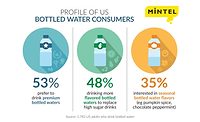Rabobank identifies gap in U.S. brandy market
Beverage brands can use halo from wine, spirits to market brandy

In Rabobank's new report about the U.S. brandy market, the New York-based financial services company identifies a clear market gap in what logically should be the segment’s strongest price segment — premium brands. Between the value, low-growth end of the brandy spectrum and the fast-growing, super-premium Cognac end, there is a potential opportunity for spirits companies to tap into the growing appetite for premium spirits among sophisticated, affluent U.S. consumers, it suggests.
The premium brandy gap, in Rabobank's view, stems from the U.S. view of Cognac and brandy as separate categories, each with its own niche set of consumers, it explains. Domestic brandy (non-Cognac) is a price-sensitive segment with lackluster sales, and this segment’s consumers tend to be older, white and less affluent, it notes. Cognac, on the other end of the spectrum, holds a strong position in the African-American market, and price growth of super-premium Cognacs is outpacing the market, it says.
U.S. brandy sales echo this divergence. For example, large volumes of domestic brands can be found in the value price segment — around $12 or $13 a bottle — however, smaller but fast-growing volumes (of mainly Cognac) exist in the super-premium segment, which generally starts at $25-$30 a bottle.
“There is an enormous gap between domestic, value brandy and super-premium Cognac: the premium segment,” said Stephen Rannekleiv, global wine and spirits analyst for Rabobank in a statement. “This is unusual because the premium segment is, generally, the strongest part of the U.S. spirits market overall. If brandy had a normal pricing curve, we estimate there would be approximately 4 million cases of premium brandy sold, at a retail value of nearly $1 billion."
In Rabobank's diagnosis, brandy's image problem stems not only from consumers perceptions but also from their lack of understanding about what brandy (including Cognac) is: distilled wine often aged in bourbon barrels. For many, brandy is associated either with elderly, pipe-smoking gentlemen in club chairs or with overly sweet fruit-flavored brandy liqueurs that taste like cough syrup, it explains. Neither of these appeals to affluent consumers taking part in the cocktail culture, it says.
"Brandy, both domestic and Cognac, has failed to gain relevance with the broader base of U.S. consumers, particularly affluent consumers who have driven recent premiumization trends in vodka, whiskey and wine,” Rannekleiv said. “Increasing brandy consumption within this broader demographic represents an opportunity for foreign and domestic brandy suppliers to expand sales, improve profitability and grow the overall spirits category."
Rabobank recognizes that overcoming some of brandy's negative stereotypes will be an uphill battle.
"Building a premium brandy brand will require significant marketing resources — something that has been missing in the brandy category — but we believe the current context may create favorable conditions to do so," Rannekleiv said. "Consumers today are more sophisticated and more open to new products and categories. Furthermore, the growing interest in premium wine and whiskey creates an ideal opening to reintroduce brandy to consumers using the halo from these categories, as brandy has characteristics of both (e.g., wine grape varietals used, whiskey barrel aging, etc.)."
Looking for a reprint of this article?
From high-res PDFs to custom plaques, order your copy today!






